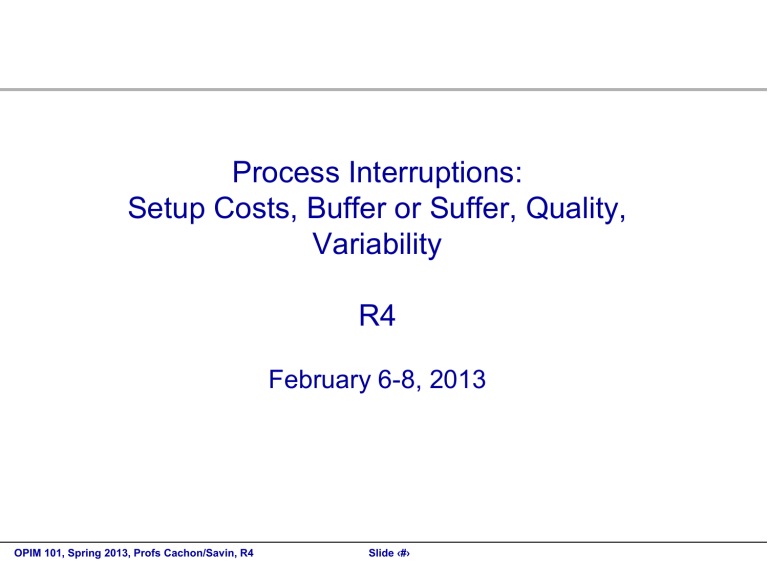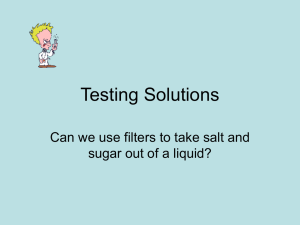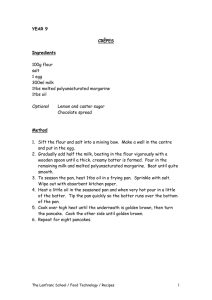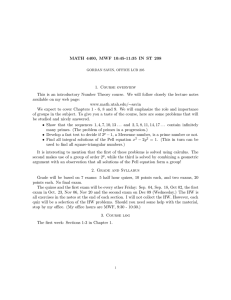
Process Interruptions: Setup Costs, Buffer or Suffer, Quality, Variability R4 February 6-8, 2013 OPIM 101, Spring 2013, Profs Cachon/Savin, R4 Slide ‹#› Powered by Koffee: A little background Powered by Koffee (PBK) is a new campus coffee store. PBK uses 50 bags of whole bean coffee every month, and you may assume that demand is perfectly steady throughout the year. PBK has signed a year-long contract to purchase its coffee from a local supplier, Phish Roasters, for a price of $25 per bag and an $85 fixed cost for every delivery independent of the order size. The holding cost due to storage is $1 per bag per month. PBK managers figure their cost of capital is approximately 2 percent per month. OPIM 101, Spring 2013, Profs Cachon/Savin, R4 Slide ‹#› Powered by Koffee: Questions Q1. What is the optimal order size, in bags? Q2. Given your answer in (a), how many times a year does PBK place orders? Q3. Given your answer in (a), how many months of supply of coffee does PBK have on average? Q4. On average, how many dollars per month does PBK spend to hold coffee (including cost of capital)? Q5. Suppose Phish Roasters is offered a 3.5% discount off the regular price of $25 if PBK purchased at least 500 bags at a time. If PBK took this deal, how many bags should they order each time. Q6. If PBK took the deal described in Q5, then what would be their annual total costs (inventory holding, ordering and purchasing costs)? OPIM 101, Spring 2013, Profs Cachon/Savin, R4 Slide ‹#› Powered by Koffee: Solution to Q1 To find out the optimal order size, it’s just a matter of plugging numbers into the EOQ formula: 2* K * R h Here, order cost (K) is $85, flow rate (R) is 50 bags/month and holding cost (h) is ($1 + 2% * $25) = $1.50 per unit per month. The optimal order size is 75.3 bags. OPIM 101, Spring 2013, Profs Cachon/Savin, R4 Slide ‹#› Powered by Koffee: Solution to Q2 Yearly demand is: 12 months/yr *50 bags/month = 600 bags/yr PBK must place: Order size = 75.3 bags/order 600/75.3 = 7.97 orders a year. OPIM 101, Spring 2013, Profs Cachon/Savin, R4 Slide ‹#› Powered by Koffee: Solution to Q3 The average inventory is half of the order quantity and hence 75.3/2 = 37.6 bags. Because the monthly demand is 50 bags, the average inventory can supply 37.6/50 =0.753 months (or about 3 weeks) OPIM 101, Spring 2013, Profs Cachon/Savin, R4 Slide ‹#› Powered by Koffee: Solution to Q4 Cost of holding one bag for one month: $1 of storage plus $25 * 2% = $0.50 cost of capital. Because the average inventory is 37.6 bags, the monthly total holding cost is 37.6 * ($1 + $0.50) = $56.46/month OPIM 101, Spring 2013, Profs Cachon/Savin, R4 Slide ‹#› Powered by Koffee: Q5 Q5. Suppose Phish Roasters is offered a 3.5% discount off the regular price of $25 if PBK purchased at least 500 bags at a time. If PBK took this deal, how many bags should they order each time. Is it a good deal? Which one leads to lower total costs? Total cost = C(Q) + unit costs KR 1 h Q Rc Q 2 Setup OPIM 101, Spring 2013, Profs Cachon/Savin, R4 Holding Slide ‹#› Purchasing costs c is per-unit cost Powered by Koffee: Q5 Monthly costs: KR 1 h Q Rc With no deal Q 2 85 50 75.3 1 2% 25 50 25 75.3 2 56.46 56.46 1250 $1362.92 KR 1 h Q Rc With deal Q 2 85 50 500 1 2% 25 (1 0.035) 50 25 (1 0.035) 500 2 8.50 370.63 1206.25 $1585.28 OPIM 101, Spring 2013, Profs Cachon/Savin, R4 Slide ‹#› Powered by Koffee: Q5 Total monthly costs are higher when they take the deal! If PBK ordered even more than 500, it only gets worse for the company (you can verify this yourself). Within the constraint of the question, however, we can suppose that the manager is informed that PBK’s CEO has already accepted this deal. Since the question asks “if PBK took this deal”, the manager should minimize the damage and order just 500. OPIM 101, Spring 2013, Profs Cachon/Savin, R4 Slide ‹#› Powered by Koffee: Q6 Q6. If PBK took the deal described in Q5, then what would be their annual total costs (inventory, ordering and purchasing costs)? We multiply the monthly cost with the deal by 12 for annual cost: KR 1 Total cost h Q Rc Q 2 85 50 500 1 2% 25 (1 0.035) 50 25 (1 0.035) 500 2 8.50 370.63 1206.25 Purchasing (annual) 12 x 1206.25 = $14,475 Setup (annual) Holding (annual) 12 x 8.50 = $102 12 x 370.63 = $4,447.50 Grand Total Annual $19,024.50 OPIM 101, Spring 2013, Profs Cachon/Savin, R4 Slide ‹#› Salt production on Vanuatu – part 1 A salt production facility on the island of Vanuatu has one salt pan (pink water in left photo) covering 6 acres. The pan is flooded with sea water, and evaporation leaves the pan dry, covered with sea salt and ready for harvesting Evaporation of a pan takes 10 weeks. Harvesting is done by bulldozers. OPIM 101, Spring 2013, Profs Cachon/Savin, R4 Slide ‹#› Salt production on Vanuatu – part 2 A single bulldozer requires 3 days to harvest each acre of salt and this facility has 2 of them. Harvesting can occur any day during the week and clearly the pan cannot be flooded during harvesting. Each acre yields 1000 cubic meters of salt. After salt is harvested from a pan, it is flooded with sea water to begin the process again. How much salt can this facility produce per day? OPIM 101, Spring 2013, Profs Cachon/Savin, R4 Slide ‹#› Salt production for a 6-acre pan 70 days 9 days Evaporate Harvest Evaporation takes 10 weeks = 70 days Harvest takes 9 days per pan: 6 acres x 3 days per acre per bulldozer / 2 bulldozers = 9 days There is no inventory between Evaporation and Harvest! Hence, Evaporation cannot “work” at the same time as Harvest! So it takes 70 + 9 = 79 days to produce one 6 acre pan. OPIM 101, Spring 2013, Profs Cachon/Savin, R4 Slide ‹#› Salt production per 6-acre pan per day 70 days 9 days Evaporate Harvest So 79 days produces 6 acres. 6 acres yields 6 x 1000 m3 = 6000 m3 of salt. Hence, 6000 / 79 = 76.0 m3 per day per pan OPIM 101, Spring 2013, Profs Cachon/Savin, R4 Slide ‹#› Salt production with an “inventory buffer” 70 days 9 days Evaporate Harvest If Evaporation and Harvest could work independently then evaluate each capacity separately: Evaporation: 6000 m3 / 70 days = 85.7 m3 / day Harvest 6000 m3 / 9 days = 667 m3 / day Evaporation would be the bottleneck and the process would produce 85.7 m3 / day OPIM 101, Spring 2013, Profs Cachon/Savin, R4 Slide ‹#› Bonus questions - Salt production on Vanuatu How much salt could they produce if they have 7 salt pans, each 6 acres? How much salt can they produce if they have 10 salt pans, each 6 acres? How much salt can they produce if they have 2 salt pans, each 3 acres? Why is this different than one 6 acre salt pan? OPIM 101, Spring 2013, Profs Cachon/Savin, R4 Slide ‹#› Bonus - Salt production with 7 pans 70 days 9 days Evaporate Harvest Each pan produces 76.0 m3 per day Assume there is never two pans ready to harvest at the same time… Then they can produce 76 x 7 = 532 m3 per day Check that the assumption holds… Harvesting 6 pans takes 6 x 9 = 54 days Evaporating one pan takes 70 days So after harvest pan 1, the bulldozers can harvest for 54 more days and finish before they need to get back to pan 1 OPIM 101, Spring 2013, Profs Cachon/Savin, R4 Slide ‹#› Bonus - Salt production with 10 pans 70 days 9 days Evaporate Harvest Harvest now is constraining To Harvest 9 pans requires 9 x 9 = 81 days So after pan 1 is harvested, it cannot be harvested again for another 81 days, but it is ready for harvesting after 70 days. So now the bulldozers work all of the time Capacity = 6000 / 9 = 667 m3 per day OPIM 101, Spring 2013, Profs Cachon/Savin, R4 Slide ‹#› Bonus: Salt production with two 3-acre pans 70 days 4.5 days Evaporate Harvest Now it takes 4.5 days to harvest 3 acres 3 acres yields 3 x 1000 m3 = 3000 m3 of salt. Hence, 3000 / 74.5 = 40.27 m3 per day per pan There are two 3-acre pans so total capacity is 2 x 40.27 = 80.5 m3 per day This is higher than one 6-acre pan because one pan can be evaporating while the other is being harvested. OPIM 101, Spring 2013, Profs Cachon/Savin, R4 Slide ‹#›



